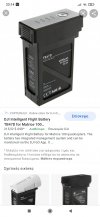In my opinion, the DJI batteries are way over engineered, hence the issues we currently have when DJI decides, we're not going to make these anymore, that and no 3rd parties willing to pay the high startup costs to make batteries. A lot of RC and other drones use the approach of having the BMS in the charger, not the battery, i.e. the batteries are dumb but the charger is smart. While you don't get the detailed cell by cell voltage and cycle telemetry DJI provides, it's not really necessary. Every time you buy a DJI battery you're basically buying a smart charger with it, adding weight.
With proper design, as long as the discharge rating of the cells exceeds the draw, temperature is of little concern while in use, you will never over tax the batteries with the exception of over discharge. A temperature probe is really only beneficial while charging. I use the touch the cell approach and look to see if the input Amps are declining or a cell is taking too long to balance.
The batteries in my big electric helis, never get hot.
Using any of these (smart or dumb) batteries safely, requires active participation while in use. Complacency is the enemy.
As far as cycles, the rated cycles are an average. Some get more some less. I'm not concerned with cycles, I'm concerned with internal resistance. A full cycle is a complete charge and discharge, anything less is a fraction of a cycle. Some batteries should be replaced with very few cycles. And yes, at some point with age, the internal resistance increases, the run time fades and the batteries will need to be replaced, all of which can be determined while charging before use. Most of the information I get from a smart charger, I can't get from DJI batteries, we have to trust the BMS. Most people that have issues, try running batteries that should have been replaced long ago, continuing to use them like they were new. I'm not faulting them, given the high cost, and few replacement options it's not surprising. High cost, "being smart", forced obsolescence, basically encourages bad behavior, like over use, attempted personal rebuilding, cheap jury-rigging, etc., all negating any perceived safety benefits.
Voltage and charge remaining can still be provided through telemetry with so called dumb batteries.
Batteries shouldn't be left alone while charging anyway. Having the BMS separate from the battery reduces weight and cost. Personally I prefer to use a balance charger/tester of my choosing on the balance leads. Having started early in this hobby with LiPo's, I was forced to learn and make some expensive mistakes.
How many Tesla's crashed because with autopilot, drivers abdicated their responsibility of being the driver, or automation in a cockpit leading to softened pilot skills, etc.
https://batteryuniversity.com/ is a great resource regarding all sorts of cell and battery chemistries.
All that said, DJI batteries have caught fire, just like all the others using different approaches, are they statistically any safer? I don't know, but to me just more expensive and something else to break.






